Whenever I meet a Pitsky during my shifts at the clinic, it’s always a memorable moment. These dogs have a way of mixing the fierce loyalty of a Siberian Husky with the courageous heart of an American Pitbull Terrier, creating a companion that’s both stunning and spirited. They’re not just pets; they embody an adventure, wrapped up in a fur coat that catches every eye.
In my experience, each Pitsky has a way of speaking through their eyes—one might be ice blue, the other a deep chocolate, offering a glimpse into their vibrant souls. It’s like each look tells a story of loyalty and lively spirit, which never fails to draw me in.
Walking down the street with a Pitsky by your side is an experience like no other. Heads turn, and smiles spread, as this canine exudes a charisma that’s both magnetic and mysterious. It’s not just their appearance that captures hearts, but the vibrant energy they bring to every moment, making every day a little more exciting than the last.
TABLE OF CONTENTS
- Pitsky Quick Breed Summary Table
- Origins of the Pitsky
- Physical Appearance of the Pitbull Husky Mix
- Personality and Temperament of a Pitsky
- How to Take Care of a Pitsky
- How to Train a Pitsky
- The Most Common Health Problems Among Pitbull Huskies
- The Costs of Owning a Pitsky
- FAQs: About the Pitsky
- So, Is the Pitsky Right for You?
- Other Husky and Pit Bull Mixes
Pitsky Quick Breed Summary Table
Origins of the Pitsky
The Pitsky is a testament to the magic that happens when two distinctly different dog breeds merge. Not officially recognized by major kennel clubs, the Pitsky is what we call a designer hybrid, born from the desire to blend the physical and temperamental traits of the Siberian Husky and the American Pit Bull Terrier. While it’s tough to pinpoint the exact moment this breed was intentionally created, it’s generally agreed that the Pitsky started gaining popularity in the early 2000s.
The Siberian Husky Heritage
Siberian Huskies are the poster children for endurance and resilience, originally bred by the Chukchi people in Siberia to pull sleds over long distances. With their stunning coat and captivating blue or multi-colored eyes, they’re built for harsh conditions but are known for their friendly demeanor. In my time working with Huskies, I’ve always admired their independence and how they maintain their cool, even in stressful situations at the clinic.
The American Pit Bull Terrier Lineage
On the other half of the mix, we have the American Pit Bull Terrier—often just called the Pitbull. This breed has a history that dates back to early 19th-century England, where they were bred for bull-baiting. When this cruel sport was outlawed, they crossed the ocean to America, where they became beloved as farm dogs and family companions. Despite their tough exterior, the Pitbulls I’ve cared for have been some of the most affectionate pups, always eager to offer a belly for rubs or a nuzzle into your hand.
The Rise of the Pitsky
The history of the Pitsky as a distinct hybrid breed is relatively recent, blossoming primarily during the designer dog movement that gained momentum in the late 1990s and early 2000s. This was a time when breeders began to intentionally cross purebred dogs to combine their desirable traits, hoping to create the perfect companion animal with specific aesthetic and temperamental qualities.
The Pitsky was one of these creations, designed to blend the endurance and striking appearance of the Siberian Husky with the strength and loyalty of the American Pit Bull Terrier. Breeders aimed to achieve a dog that possessed the physical prowess and energy levels suitable for active homes, along with a temperament that makes for a loving family pet. While not recognized by major kennel clubs, which tend to focus on purebreds, Pitskies have carved out their niche in the hearts of those who cherish the unique and the spirited.
Physical Appearance of the Pitbull Husky Mix
The Pitsky, a stunning blend of Siberian Husky and American Pit Bull Terrier, showcases a physical appearance as varied as it is striking. In every Pitsky, you see a marvelous blend of traits inherited from their diverse parentage, which makes them not only unique but truly captivating
Height and Weight
When you first lay eyes on a Pitsky, you’ll notice they strike a fine balance in size—neither too large nor too small. Typically, these dogs stand about 19 to 21 inches at the shoulder, though I’ve seen some who are slightly shorter, taking after their Pitbull parent.
As for weight, they range from a sturdy 30 to 70 pounds. During my routine check-ups at the clinic, I always advise Pitsky owners to keep an eye on their pet’s weight to ensure they stay within this healthy range, as both parent breeds can be prone to obesity without proper care.
Coat and Color
One of the most enchanting features of the Pitsky is their coat. It can vary widely due to the diverse coat types of their parent breeds. Some inherit the Husky’s thick, double-layer coat that’s meant for colder climates, while others might have a shorter, denser coat like the Pitbull’s. Regardless, they often require regular grooming to manage shedding, especially if they lean towards the Husky’s side.
The color palette of a Pitsky’s coat is like opening a box of crayons—full of surprises. They can come in a variety of colors, ranging from black, white, grey, brown, to even a blend of colors that mirror the Husky’s typical markings. I remember one Pitsky, Bella, who had the most striking coat pattern; she looked like she’d dipped her toes in white paint, with a mask that perfectly framed her eyes.
Other Physical Features
Pitskies often inherit the mesmerizing eye colors of the Husky—bright blue or even heterochromia (two different colored eyes)—which never fails to captivate. Their ears can either be perky like a Husky’s or slightly folded at the tip, similar to a Pitbull’s, giving them a perpetually alert and curious expression. Their build reflects their athletic nature, with a robust frame that supports a muscular stature, perfect for those who lead an active lifestyle.
Every Pitsky I meet at the clinic brings a new level of awe with their distinct looks and lively character. It’s a joy to see such diversity within a single breed, making each appointment a unique discovery of what the combination of a Pitbull and Husky can produce.
Personality and Temperament of a Pitsky
The Pitsky, a blend of Pitbull and Husky, showcases a personality that’s as vibrant as their striking looks. These dogs combine the affectionate and loyal nature of the Pitbull with the energetic and free-spirited demeanor of the Husky, making for a companion who’s both playful and protective.
The Energetic Enthusiast
Pitskies inherit a robust energy level that can make them the life of any party. They’re animated and spirited, qualities drawn from both the Siberian Husky and the American Pit Bull Terrier. From my time in the clinic, it’s clear that a Pitsky’s day is packed with bursts of excitement, whether it’s during a routine check-up or a walk in the park. Their enthusiasm is palpable, and it demands an outlet through regular, vigorous exercise.
However, managing their energy is crucial. Without adequate physical activity, a Pitsky can become restless and may resort to less desirable behaviors like chewing or excessive barking. I’ve advised many Pitsky owners on the importance of a daily exercise regimen that goes beyond a simple walk—think long hikes, runs, or agility training. These activities help channel their energy positively and deepen the bond between pet and owner.
A Loyal Companion
One of the most endearing traits of a Pitsky is their deep-seated loyalty, a characteristic prominently inherited from the Pitbull side of the family. They develop strong attachments to their families and can be incredibly protective. This loyalty makes them excellent companions, always ready to stand by their owner’s side. In the clinic, I’ve seen Pitskies who remain calm by their owner during stressful procedures, demonstrating their unwavering support.
Yet, this loyalty can sometimes translate into a protective nature that needs careful handling, especially around strangers or new environments. Early socialization is key—I always stress to Pitsky owners the importance of introducing their dogs to a variety of people, animals, and settings from a young age. This helps ensure that their protective instincts are well-balanced with a friendly demeanor, allowing them to discern when to guard and when to greet.
How to Take Care of a Pitsky
Caring for a Pitsky is a delightful challenge that blends the energetic needs of a Husky with the affectionate nature of a Pitbull. This hybrid thrives on attention and activity, so if you’re considering bringing a Pitsky into your life, it’s crucial to understand how to meet their needs properly.
Feeding
- Diet Needs: Pitskies are energetic and muscular, requiring a balanced diet rich in proteins and fats to maintain their vigor and coat health. I recommend a high-quality dog food that suits their age, weight, and energy level. It’s important to avoid overfeeding, as both parent breeds can be prone to obesity.
- Feeding Schedule: Consistency is key. Feeding them at the same times every day helps prevent overeating and weight issues. For adult Pitskies, two meals a day is generally sufficient, but puppies may require more frequent feeding to support their growth.
Grooming
- Coat Care: Depending on their coat type, which can vary from short and dense to long and fluffy, grooming needs can differ. For those with a Husky-like coat, regular brushing—about three times a week—is essential to manage shedding and keep their coat healthy. Pitskies with shorter coats may get by with less frequent grooming.
- Bathing and Nails: Bathing your Pitsky once every couple of months or as needed is generally enough to keep them clean without drying out their skin. Also, keep an eye on their nails; if you hear them clicking on the floor, it’s time for a trim.
Exercise
- Daily Activity: Pitskies inherit a high energy level from both parent breeds. They require at least an hour of vigorous exercise daily to remain fit and happy. Regular walks, runs, or hikes are great, and they also enjoy play sessions that can include fetch or tug-of-war.
- Suitable Activities: Because of their intelligent and adventurous nature, Pitskies excel in activities that challenge them physically and mentally. Agility training or canine sports like flyball can be excellent outlets for their energy.
Mental Stimulation
- Interactive Toys: To keep their minds sharp and engaged, provide a variety of interactive toys such as puzzle feeders or treat-dispensing toys. These not only entertain them but also help manage their energy levels by giving them something constructive to focus on.
- Training and Socialization: Continuous training and socialization are crucial for Pitskies. They are smart and learn quickly, but they can also inherit a stubborn streak from the Husky side. Regular, positive reinforcement-based training sessions help strengthen your bond and keep behavioral issues at bay.
How to Train a Pitsky
The training journey with a Pitbull Husky Mix offers an exciting blend of challenges and rewards. Known for their sharp intellect and an occasional stubborn streak, these dogs inherit traits from both the Husky and Pitbull breeds, making their training both unique and engaging.
Establishing Basic Obedience
- Start Early: The key to shaping a well-mannered Pitsky is to start training as early as possible. Puppies are incredibly receptive, and early socialization and basic commands set a foundation for more advanced training later. In my practice, I always advise new Pitsky owners to begin with simple commands like ‘sit’, ‘stay’, ‘come’, and ‘heel’ as soon as they bring their puppy home.
- Consistency Is Crucial: Because Pitskies can show a stubborn streak, particularly inherited from their Husky parent, consistency in training is crucial. Use clear and consistent commands, and ensure that everyone in your household is on the same page to avoid confusing your dog.
Positive Reinforcement Techniques
- Rewards Work Wonders: I’ve found that Pitskies respond excellently to positive reinforcement. This means rewarding good behavior with treats, praise, or playtime, which encourages them to repeat those behaviors. It’s important to recognize their efforts immediately, so they understand exactly what action is being rewarded.
- Avoid Negative Reinforcement: Due to their sensitive nature, particularly inherited from the Pitbull side, Pitskies can become shut down or defensive if scolded or punished harshly. Instead, focus on redirecting unwanted behaviors and rewarding the behaviors you want to encourage.
Advanced Training and Socialization
- Keep Challenging Them: Once your Pitsky has mastered the basics, don’t stop there. These dogs thrive on mental stimulation and physical challenges. Introducing them to advanced obedience classes, agility training, or even scent work can help keep their minds and bodies active. It’s a joy to see them light up when tackling a new challenge!
- Continuous Socialization: Socialization isn’t just for puppies. Continuing to expose your Pitsky to different people, animals, and environments throughout their life helps them remain adaptable and friendly. Regular visits to parks, pet-friendly stores, and social events are great ways to keep your Pitsky well-rounded and socially savvy.
The Most Common Health Problems Among Pitbull Huskies
Pitbull Husky mixes, or Pitskies, are generally hearty dogs, but like all breeds, they have their susceptibilities to certain health issues. Understanding these common health problems can help owners provide the best care for their furry friends.
Hip Dysplasia
Hip dysplasia is a common genetic condition in Pitskies, stemming from both parent breeds. It involves a malformation of the hip joint, leading to arthritis or discomfort as the dog ages.
- Symptoms: Limping, difficulty rising, reluctance to run or jump.
- Prevention: Maintain a healthy weight to reduce stress on the joints.
- Treatment: Options include physical therapy, anti-inflammatory medications, and in severe cases, surgery.
Allergies
Pitskies often inherit a predisposition to allergies, which can manifest in various forms such as skin irritations, dietary sensitivities, or environmental allergies.
- Symptoms: Itchy skin, excessive licking, redness, and digestive issues.
- Prevention: Identify and avoid allergens, which may require special diets or changes in the environment.
- Treatment: Treatments can include antihistamines, special shampoos, or prescription diets depending on the allergy type.
Cataracts
Cataracts can affect Pitskies, particularly as they age, leading to a cloudiness in the lens of the eye that impairs vision.
- Symptoms: Cloudy or bluish appearance to the eyes, clumsiness.
- Prevention: Regular vet check-ups to catch issues early.
- Treatment: In cases that significantly impair vision, surgery may be necessary to restore sight.
Hyperthyroidism
Hyperthyroidism, though less common in dogs than hypothyroidism, can occur in Pitskies. This condition involves an overproduction of thyroid hormones, which can significantly accelerate the dog’s metabolism, leading to various health challenges.
- Symptoms: Increased appetite, weight loss, hyperactivity, increased thirst, and frequent urination.
- Prevention: Regular veterinary check-ups to monitor thyroid function.
- Treatment: Treatment typically involves medication to regulate thyroid hormone levels, and in some cases, surgical removal of the thyroid gland may be considered.
The Costs of Owning a Pitsky
Bringing a Pitsky into your life is an exciting decision that comes with both joy and responsibility. Like any pet, Pitskies have specific needs that can influence the overall cost of ownership. From initial expenses to ongoing care, understanding these costs can help you prepare to provide the best for your new companion.
Initial Costs
When you first decide to adopt or purchase a Pitsky, there are several upfront costs to consider:
- Purchase Price: Depending on the breeder and the region, the cost of a Pitsky puppy can range significantly. Typically, prices can vary from $500 to over $1,000.
- Supplies: Initial supplies including a crate, bedding, bowls, and toys can add up. Expect to spend around $200-$300 to get everything your new pup needs.
- Veterinary Care: Initial vaccinations, microchipping, and spay/neuter procedures are crucial. These can cost anywhere from $100 to $300, depending on your location and the vet clinic.
Ongoing Expenses
Once your Pitsky is comfortably settled at home, you’ll need to budget for ongoing expenses to keep them healthy and happy:
- Food: Pitskies are energetic and require a nutritious diet. High-quality dog food can cost about $40-$80 per month.
- Routine Veterinary Care: Annual check-ups, vaccinations, and preventative medications for fleas, ticks, and heartworm are necessary. These costs typically range from $200 to $600 annually.
- Grooming: Depending on their coat type, Pitskies may need regular grooming. Even for minimal grooming, set aside around $30-$50 per session.
- Training and Socialization: Proper training is crucial, especially in the early stages. Group training classes or private sessions can vary widely in cost, generally ranging from $50 to $200 per session.
Unexpected Costs
Finally, it’s wise to prepare for unexpected costs:
- Emergency Veterinary Care: Accidents and illnesses can happen, and emergency vet visits can be expensive, often costing hundreds or even thousands of dollars.
- Health Issues: As discussed, Pitskies can inherit certain health problems that might lead to significant veterinary bills. It’s a good idea to set aside a fund or consider pet insurance to help manage these potential expenses.
FAQs: About the Pitsky
What is the lifespan of a Pitsky?
The lifespan of a Pitsky typically ranges between 12 to 15 years, depending on various factors such as genetics, overall health, and lifestyle. Providing a balanced diet, regular exercise, and routine veterinary care can help maximize their lifespan. It’s also important to address any health issues early, as this can significantly impact their quality of life and longevity.
Are Pitskies good with children?
Pitskies can be excellent family pets and are generally good with children, especially when they have been properly socialized from a young age. Their energetic and playful character makes them great companions for kids who are old enough to interact with dogs safely. However, like all dog breeds, it’s crucial to supervise interactions between children and dogs to ensure the safety of both.
Can Pitskies live in apartments?
While Pitskies can adapt to apartment living, they thrive best in environments where they have plenty of space to expend their energy. If living in an apartment, it’s essential to commit to daily exercise routines and regular trips to places where they can run and play. Additionally, mental stimulation through toys and training can help manage their energy levels indoors.
Do Pitskies get along with other pets?
Pitskies can get along well with other pets, especially if they are raised together from a young age or are properly introduced in a controlled and positive manner. However, due to their high prey drive inherited from the Husky side, careful introductions and supervision are essential when interacting with smaller animals. Consistent training and socialization play a crucial role in helping Pitskies develop good social habits with other pets.
Are Pitskies prone to separation anxiety?
Yes, Pitskies can be prone to separation anxiety due to their strong bonds with their families. This breed thrives on companionship and can become distressed if left alone for long periods. To mitigate this, it’s important to gradually acclimate them to being alone by starting with short separations and gradually increasing the time. Providing engaging toys and creating a comforting environment can also help ease their anxiety.
Can a Pitsky be a mix of a Pit Bull and a different type of Husky?
Yes, a Pitsky can indeed involve different types of Huskies, not just the Siberian Husky. While the Siberian Husky is the most commonly referenced in the context of Pitsky mixes, other Husky breeds like the Alaskan Husky can also be used to create a Pitsky.
So, Is the Pitsky Right for You?
The Pitsky, with its unique blend of Siberian Husky and American Pit Bull Terrier traits, is a dynamic and engaging companion. This breed combines the Husky’s adventurous spirit and the Pitbull’s unwavering loyalty, creating a dog that is both energetic and affectionate. Whether you’re considering adding a Pitsky to your family or just curious about what it takes to care for one, it’s important to understand the kind of commitment required to ensure a happy and healthy life for these remarkable dogs.
Pitskies Are For
- Active Outdoor Lovers: Pitskies are ideal for individuals or families who enjoy outdoor activities and want a dog that can keep pace with an adventurous lifestyle. They need owners who can provide daily vigorous exercise and playtime to keep them both physically and mentally stimulated.
- Experienced Dog Owners: This breed thrives under the care of those who have experience with dogs and understand the importance of consistent, positive training methods and ongoing socialization.
- Enthusiastic Trainers: Owners who enjoy the challenge of working with a smart but sometimes stubborn dog will find Pitskies rewarding. They require dedicated training to manage their high energy levels inherited from both the Husky and Pitbull sides.
Pitskies Are NOT For
- First-time Dog Owners: Pitskies might not be suitable for those new to dog ownership, as they demand an understanding of dog behaviors and training techniques that may be overwhelming for novices.
- The Overly Busy: Individuals with demanding schedules who cannot commit significant time daily to exercise and engage with their dog may find Pitskies too high-maintenance.
- Seekers of Low-maintenance Pets: If you prefer a low-energy, easygoing pet, a Pitsky may not be the right choice. They require a lot of physical activity and mental engagement to stay healthy and happy.
- Apartment Dwellers with Limited Access to Outdoor Space: Unless committed to regular visits to parks or open spaces where their Pitsky can exercise, people living in apartments might find it challenging to meet the needs of this breed.
Other Husky and Pit Bull Mixes
If you’re interested in learning about other Siberian husky mixes or pit bull mixes, check out the hybrid dog breeds below.
Siberian Husky Mixes
- Australian shepherd husky mix
- Pomeranian husky
- Corgi husky mix
- German shepherd Husky mix
- Husky Lab mix
- Pomsky
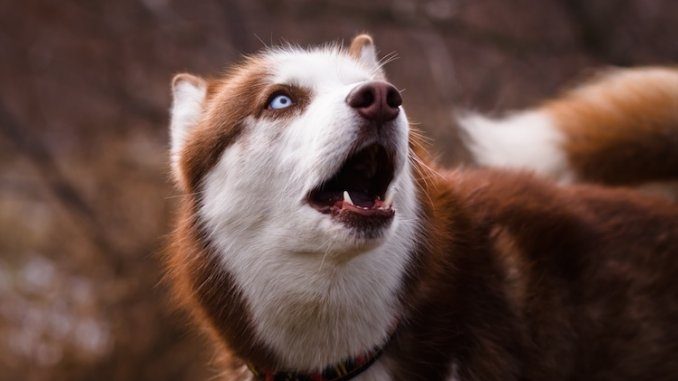
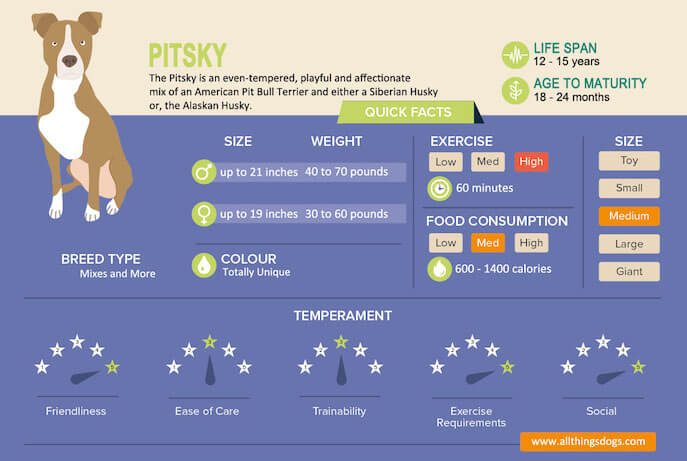
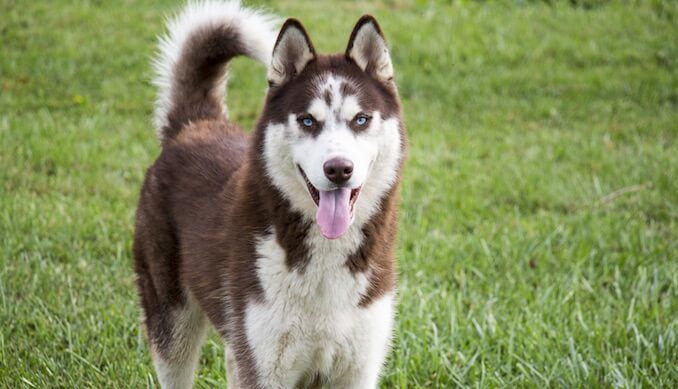
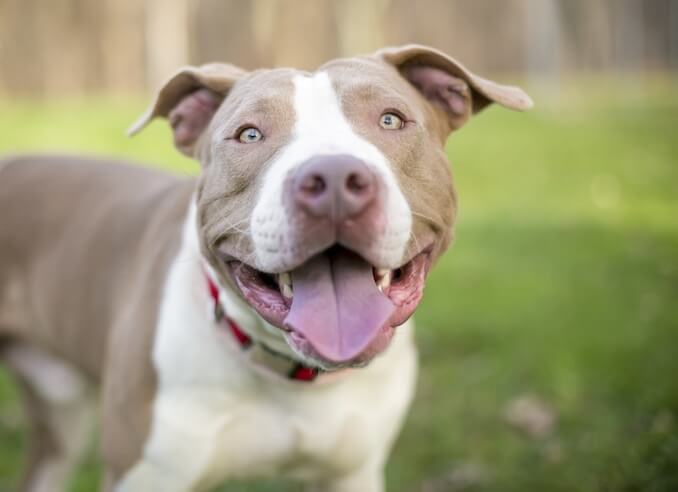
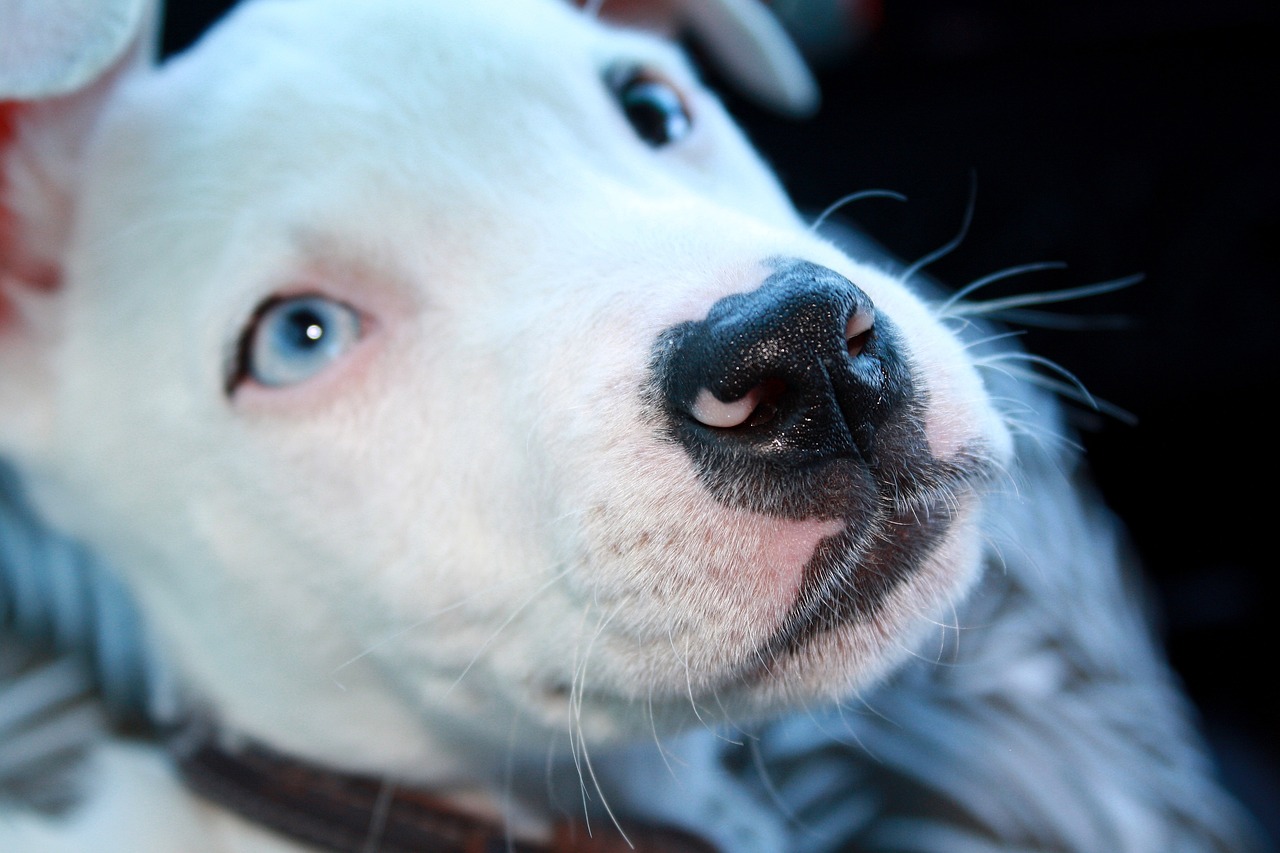

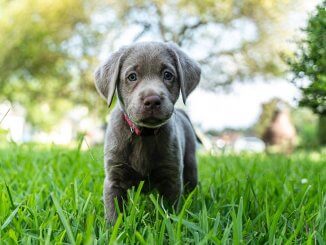
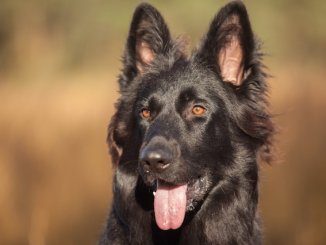
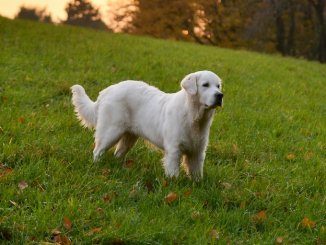
My Cleopatra is a fawn color, ice blue eyes,so sweet and lovable. Your article was very true to her pitsky breed. She is my therapy girl and just knows when I need her most! Not sure if I saved her or she saved me. She was a rescue girl who found me in a blizzard and wanted inside. I melted seeing her blue eyes.
Hello! I was wondering if Pitskies are alright being in the cold? I live in Minnesota- a very cold state and I will be receiving two pitskies. Is it safe for them to be taken outside in the cold? Thanks!
Hi Marangelyn,
Huskies are sled dogs, so historically they have been used to the cold but with a mix, you may end up with more Pit than Husky.
Huskies have double coats which insulates them in the cold, Pits have a short coat which doesn’t provide as much insulation. But, you won’t be the only person to own a pooch in Minnesota, so there are things you can do to keep safe.
I have a Pitsky named Penny. She has short hair but prefers outside in snow, even in the polar vortex! Last year -25 degrees she played in the snow for hours on end and never showed signs of being too cold in fact when we brought her back in she wanted right back out but I was too cold!
Hello! My girlfriend and I just met a four month old Pitsky that we are interested in adopting. This puppy has lived on a farm since birth and has had very little socialization. She was very shy around us and her owner. She kept her distance the whole time. Her brother however, was very friendly and came right up to us to be pet, even though they were both raised in the same environment. The owner said she was the only puppy in the litter that was shy. She has never been on a leash and has been an outside dog on the same farm since birth. We are a bit concerned seeing as how we missed the crucial puppy socialization period. Do you have any advice on how we would be able to get her to warm up to people?
I have a 3 year old Pitsky. She attacks any animal that comes in my yard. Squirrels, bunnies, cats, and a woodchuck once and most the time. They end up dying. When she gets the animal she doesn’t shake it like she’s trying to kill it. But I can’t get her attention at all. Idk how to get her to stop attacking animals. I have 2 smaller dogs at home she’s never had an issue with. Help please?
The prey drive for these dogs can be quite high – it also gets reinforced each time she gets the thrill of the chase. It would be essential to stop her before the opportunity arises, so if necessary keep her attached to a long line. At least then if she notices something you have a chance of preventing her from catching it. Alongside this you need to teach her to stop this behavior. She needs to learn leave or stop commands. So, start training them in a quiet environment, and then slowly introduce distractions to solidify the behavior. You need to work on her focus on you, so spend some time on checking in. In short, every time she checks in with you (looks at you), reward her. Separately, to fulfil her want to chase, you can introduce a flirt pole. This gives her opportunities to chase and tug, but you are also starting and stopping this behavior, so she learns when it is appropriate to demonstrate it, and when it’s not. There are plenty of videos on YouTube to help you learn how to use a flirt pole.
I have two pitsky brothers from the same litter. Yes they were a handful as pups. They chewed up a feathers sofa, but they learn fast and at 3 years old they no longer chew. If I take one away from the other they howl cry for one another. I went through a lot with them but their love and loyalty have given me so much in return.
I have an 8 year old Pitsky that has short white and tan hair with blue eyes. I adopted at 9 months old; He had been at the shelter for 7months already. He’s always been great with other dogs, kids, really everybody and everything, except cats, but he was bitten by a male Pitbull a few years ago on our morning walk and now he’s more reactive towards big male dogs. Any advice on how to help him relax on walks when walking by other dogs? He’s still great with most dogs when playing, but on a leash walking he doesn’t react great.